Unlock the Potential: 29 Creative Ideas for Decorating Bedrooms with Slanted Ceilings
Bedrooms with slanted ceilings often present a unique design challenge. You might find yourself pondering the best bed placement, how to integrate effective storage solutions, or the most flattering lighting arrangements. The unconventional angles can make furniture feel awkward and open spaces seem limited. However, these architectural features, far from being drawbacks, offer incredible opportunities to create a remarkably cozy, intimate, and truly personalized sanctuary.
If you’ve ever felt unsure about where to position your bed, how to hang lights without disrupting the flow, or worried that your favorite furniture pieces might not fit, you’re not alone. These kinds of spaces simply require a thoughtful approach and a touch of creative ingenuity to unlock their full potential. This comprehensive guide is designed to provide you with clear, actionable ideas to tackle common design dilemmas in rooms with sloped ceilings.
From clever layouts that maximize floor space to smart storage hacks and inspiring decor tips, we’ll explore solutions tailored for various needs. Whether you’re furnishing a small attic room, designing a fun and functional kids’ space, or crafting a quiet corner for relaxation, each suggestion is easy to follow and aims to help you utilize your unique dimensions more effectively. You don’t need an elaborate, high-end design to achieve a stunning result. Simple, practical changes that align with your lifestyle can transform your angled ceiling bedroom into a haven that feels more open, incredibly useful, and perfectly suited to your taste.
Bed Placement Ideas for Bedrooms with Slanted Ceilings
Finding the ideal spot for your bed is often the first and most crucial step in designing a bedroom with a slanted ceiling. The right placement can transform a challenging space into a comfortable and aesthetically pleasing retreat. These thoughtful layouts will help you use your space wisely, keeping both comfort and room flow in mind.
1. Tuck the Bed Under the Slope
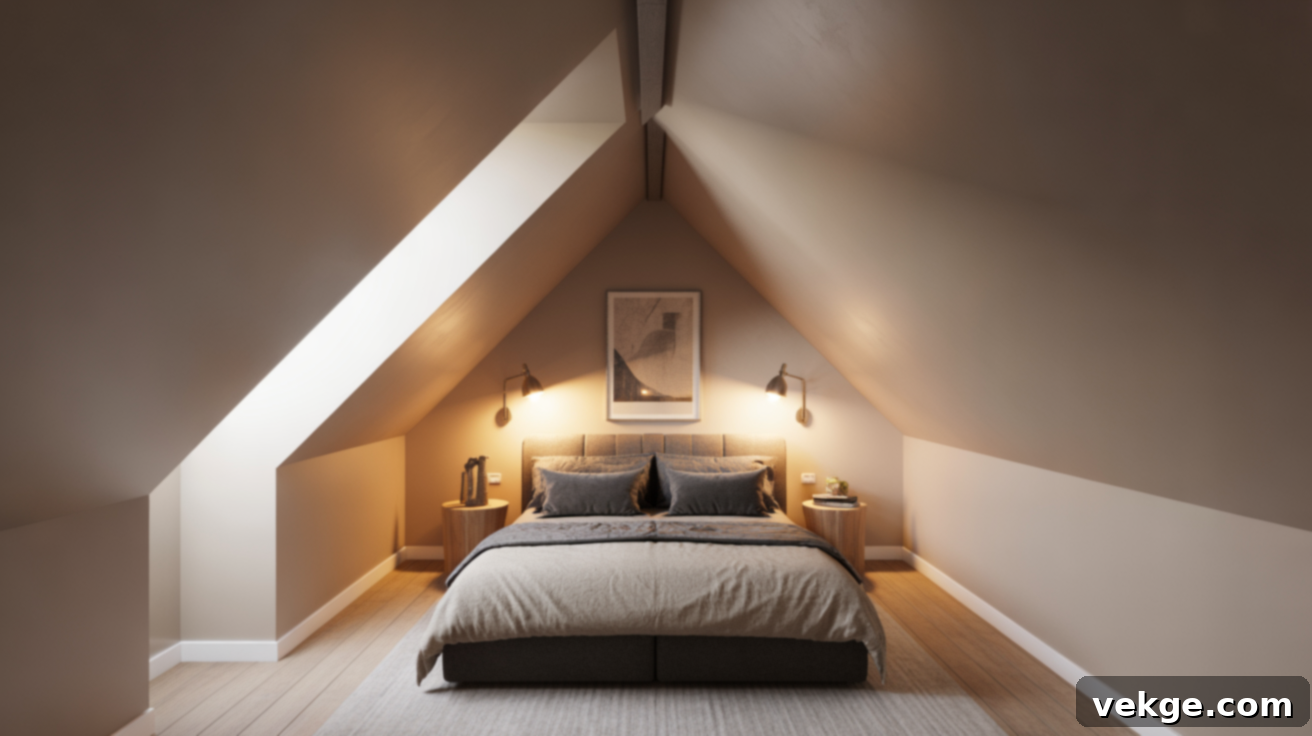
Embrace the unique architecture of your room by positioning your bed along the lowest wall where the ceiling dips. This strategic placement ingeniously utilizes an area that might otherwise be considered awkward or unusable. By placing the bed here, you open up the rest of the room, creating ample space for walking, additional seating, or practical storage solutions. This method lends a wonderfully cozy, tucked-away feel, almost like a built-in nook.
To enhance comfort and finish the look, consider adding a soft, upholstered headboard or a generous stack of pillows against the low wall. Since traditional bedside tables might not fit, opt for wall-mounted lights, such as sconces or flexible clip-on lamps, to save valuable surface space and provide ambient light for reading or relaxing.
2. Use the Tallest Wall for the Headboard
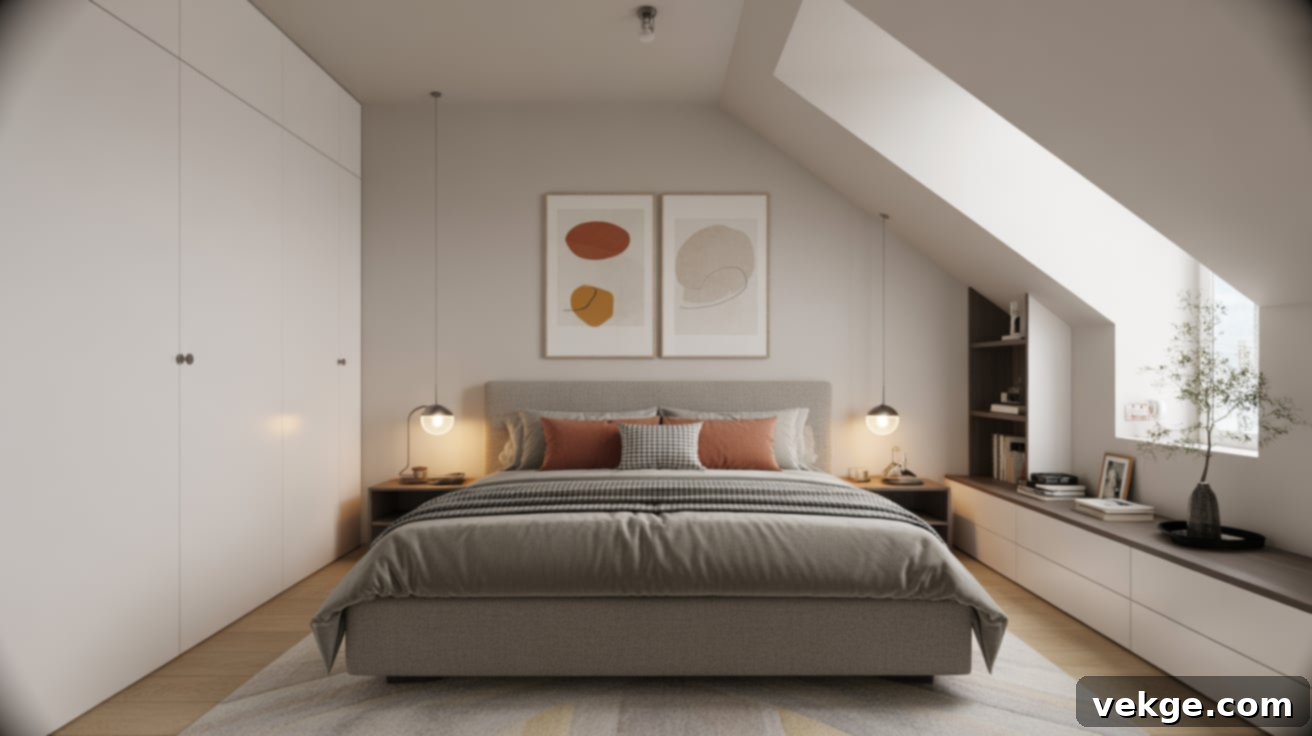
If your room features one significantly higher wall, positioning your bed so the head rests against it can be incredibly effective. This layout offers the practical benefit of more headroom, allowing you to comfortably sit up in bed to read, work, or simply relax without feeling constrained. Visually, placing the bed on the tallest wall helps to anchor the room and create a sense of balance, counteracting the downward slope on the opposite side.
This allows for the possibility of hanging simple artwork, a floating shelf, or even a subtle decorative mirror above the bed without making the space feel cramped. To maintain an open and airy atmosphere, keep the rest of this wall relatively clean and free of excessive clutter, letting the height itself be a design feature.
3. Try a Low Platform Bed

Low-profile beds, especially platform beds, are an excellent choice for bedrooms with limited ceiling height or pronounced angles. Their closer-to-the-ground design makes the entire room feel more open, less crowded, and visually expansive. This style of bed minimizes the vertical footprint, giving the illusion of more space above and around you.
You’ll find it much easier to move about the room without the constant worry of bumping your head on a low ceiling. Low platform beds also pair beautifully with complementary low shelves or compact side tables. For an added boost in functionality, consider models with integrated drawers or utilize storage boxes that slide neatly under the frame, offering discreet space-saving solutions for bedding, clothes, or other essentials.
4. Push Your Bed Into a Corner

For smaller bedrooms or those seeking an extra layer of coziness, placing your bed directly into a corner can create a wonderfully intimate and tucked-in feeling. This arrangement is particularly effective in spaces where traditional center placement feels overwhelming. By using two walls for support, this setup can also enhance a sense of warmth and can even help with sound insulation, making your sleeping area feel more private and serene.
This configuration leaves the central floor area more open, improving traffic flow. It’s also incredibly practical for adding essential items like a reading lamp that can be clipped to the headboard or a small wall-mounted shelf for books and personal items. Dress the bed with layers of soft pillows and blankets to amplify the comfortable, nest-like atmosphere.
5. Put the Bed in the Middle
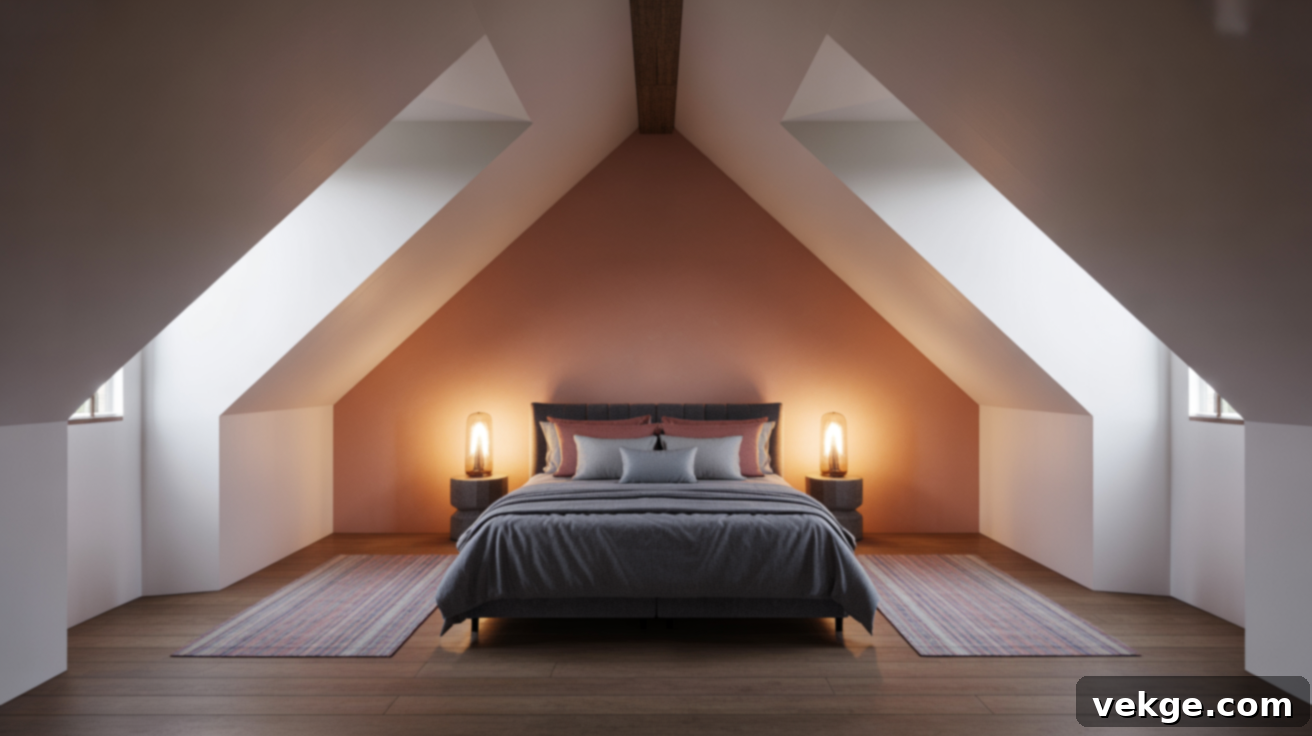
In rooms where both sides of the ceiling slope downwards, or where there isn’t a single “tall” wall, placing the bed in the center of the room can surprisingly be the most effective solution. This bold layout creates a focal point and strategically positions you away from the lowest, most restrictive spots of the ceiling, ensuring maximum headroom when sitting up or getting in and out of bed.
This central placement also allows for valuable walking space around all sides of the bed, contributing to a more open and balanced feel in what might otherwise be an awkwardly shaped room. To further define the sleeping zone and add a touch of softness, consider placing small, plush rugs on each side of the bed, enhancing both comfort and visual appeal.
Storage and Furniture That Work with a Slanted Ceiling
Effective storage is often a primary concern in bedrooms with sloped ceilings, where vertical space can be limited and traditional furniture pieces might not fit. The key is to select or customize furniture that works harmoniously with the unique shape of your room. These innovative ideas will help you maintain an organized and clutter-free space without blocking natural light or making the room feel overly crowded.
6. Add Built-in Shelves Under the Slope
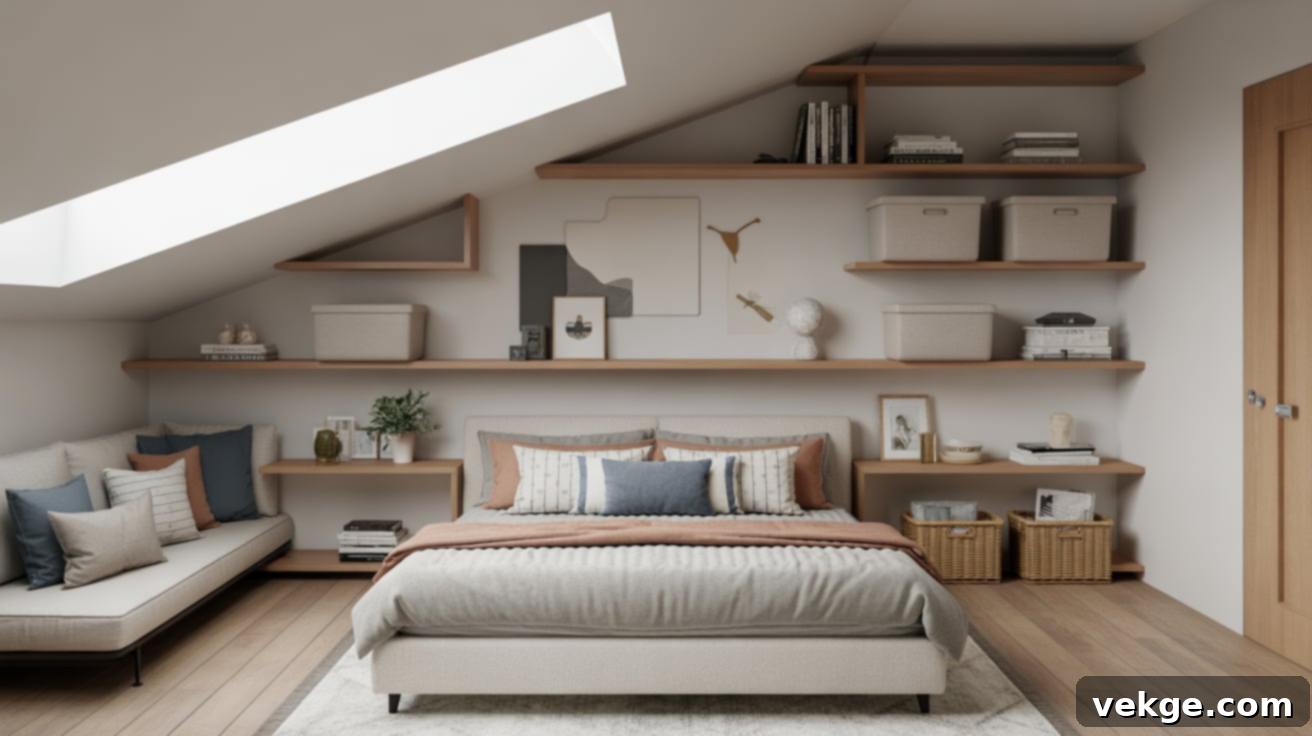
One of the most efficient ways to utilize the often-underestimated space beneath the lowest part of your slanted ceiling is by incorporating built-in or custom-fitted shallow shelves. This otherwise “dead space” transforms into a highly functional storage area, perfect for neatly organizing bins, folded clothes, shoes, or a collection of books. Built-in units offer a seamless look, making the space feel intentionally designed and fully utilized.
Opt for open shelving to prevent a bulky appearance and allow for easy access to items. For added tidiness and aesthetic appeal, use a variety of soft fabric baskets or elegant storage boxes to conceal clutter while keeping everything within reach. This approach not only maximizes storage but also adds architectural interest.
7. Use a Low Dresser or Bench
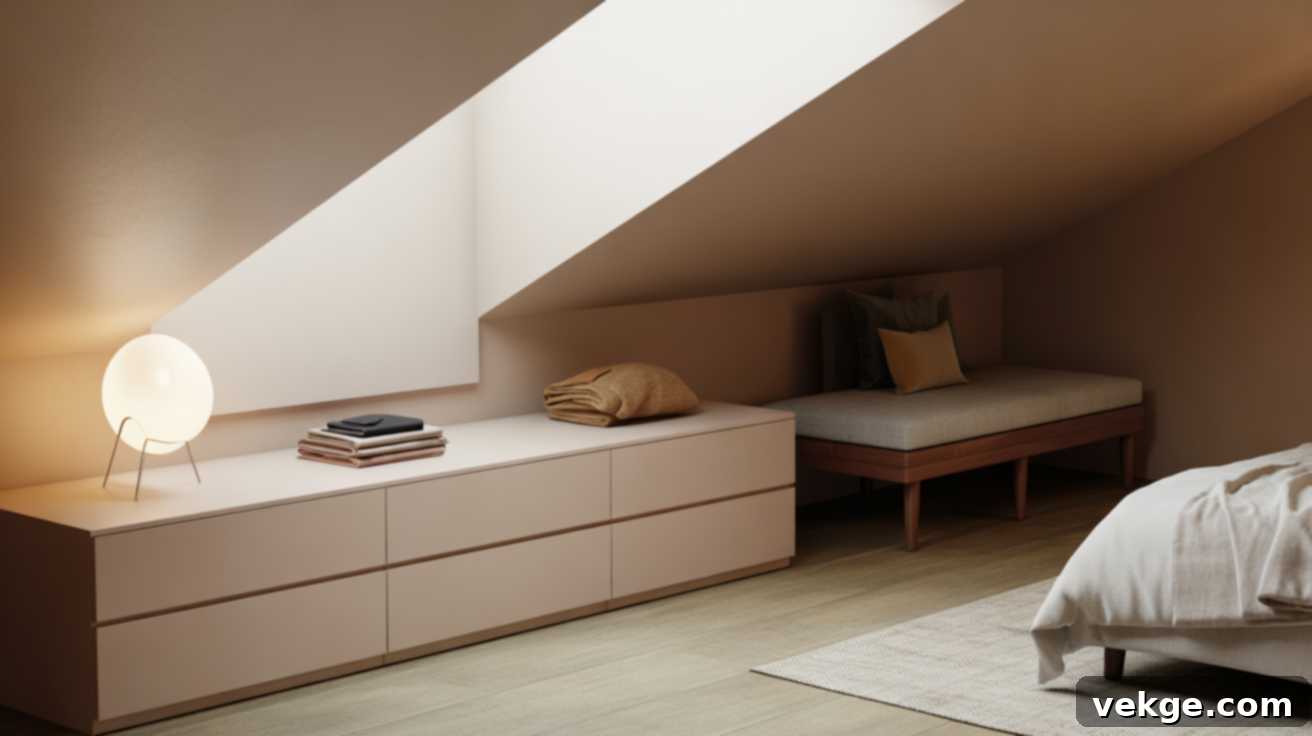
Tall dressers or wardrobes are often incompatible with angled ceilings. Instead, prioritize low-profile furniture pieces that fit perfectly beneath the sloped areas while still providing the storage you need. A short, wide dresser, a sturdy storage bench, or a classic trunk can effectively hold clothes, extra bedding, or even children’s toys.
These lower pieces of furniture are excellent for making practical use of wall space that simply cannot accommodate taller items. Choose pieces with a flat top surface, which can then double as an additional display area for decor, lamps, or personal items, further enhancing their versatility and value in a compact room.
8. Try Under-the-Bed Storage

The space beneath your bed is a frequently overlooked goldmine for storage, especially in bedrooms with slanted ceilings where floor and wall space are at a premium. This area is perfect for tucking away off-season clothing, extra shoes, blankets, or luggage. To make accessing these items effortless, invest in under-bed storage bins, ideally ones with wheels, or soft, pull-out baskets.
This method is incredibly effective at keeping your main floor area clear and significantly reduces visible clutter, contributing to a more spacious and organized feel. It’s an invaluable solution in rooms where furniture options are severely limited by ceiling height and awkward angles.
9. Create a Closet With a Curtain
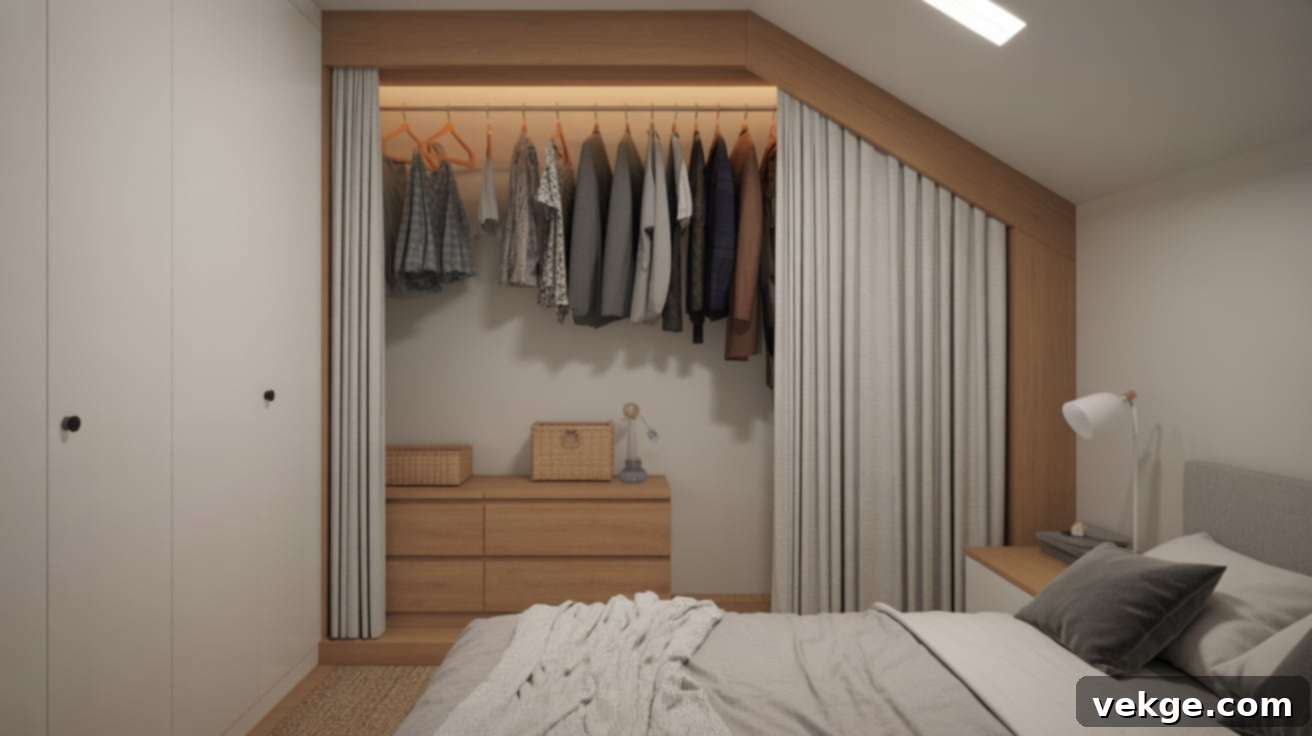
If your room lacks the space or the straight walls for a traditional built-in closet, a creative and flexible alternative is to install a hanging rod under a suitable part of the slope and conceal it with a stylish curtain. This approach instantly provides a dedicated space for hanging clothes, keeping them wrinkle-free and easily accessible.
Beyond clothing, this area can also be used to store stacked bins or shelves behind the curtain, offering versatile storage. The curtain acts as a soft barrier, keeping your items hidden from view while still allowing for quick and easy access. Select a neutral fabric or one that complements your room’s existing decor to ensure a cohesive and calm aesthetic.
10. Use Floating Shelves
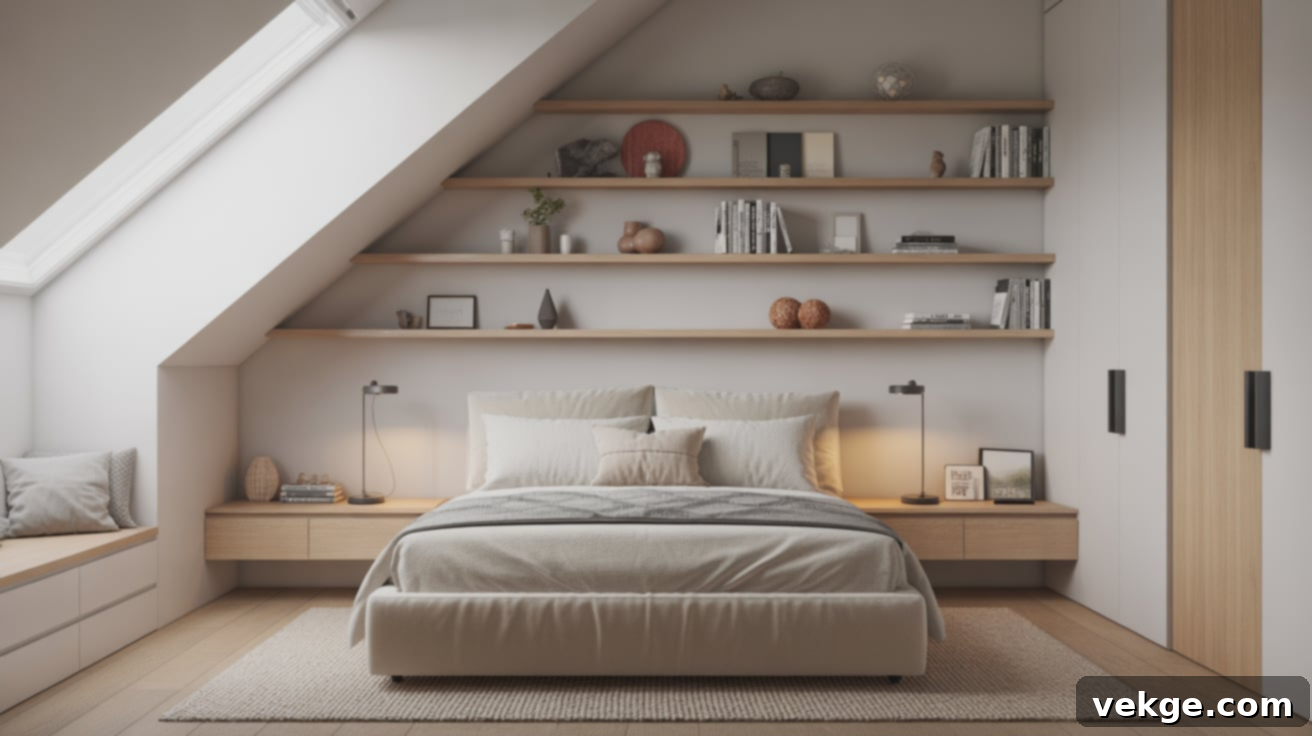
Floating shelves are an incredibly versatile storage and display solution for bedrooms with slanted ceilings. They can be installed along angled walls, between structural beams, or in any small vertical space where traditional furniture won’t fit. These minimalist shelves are perfect for keeping items off the floor without taking up visual or physical room, making your space feel lighter and more open.
You can use them to display decorative items, small collections of books, or practical storage containers. However, it’s crucial to consider their placement carefully: ensure they are not installed too low where you might bump your head, or in high-traffic areas where they could impede movement. Thoughtful placement maximizes their functionality and aesthetic appeal.
Lighting in Bedrooms with Slanted Ceilings
Effectively lighting a room with a sloped ceiling requires a bit more creativity than a standard flat ceiling. The uneven surfaces can make overhead lighting challenging and might cast unusual shadows. These innovative lighting options are designed to help you achieve optimal illumination and a welcoming ambiance without making the space feel crowded or visually unbalanced.
11. Hang Pendant Lights Closer to the Highest Point
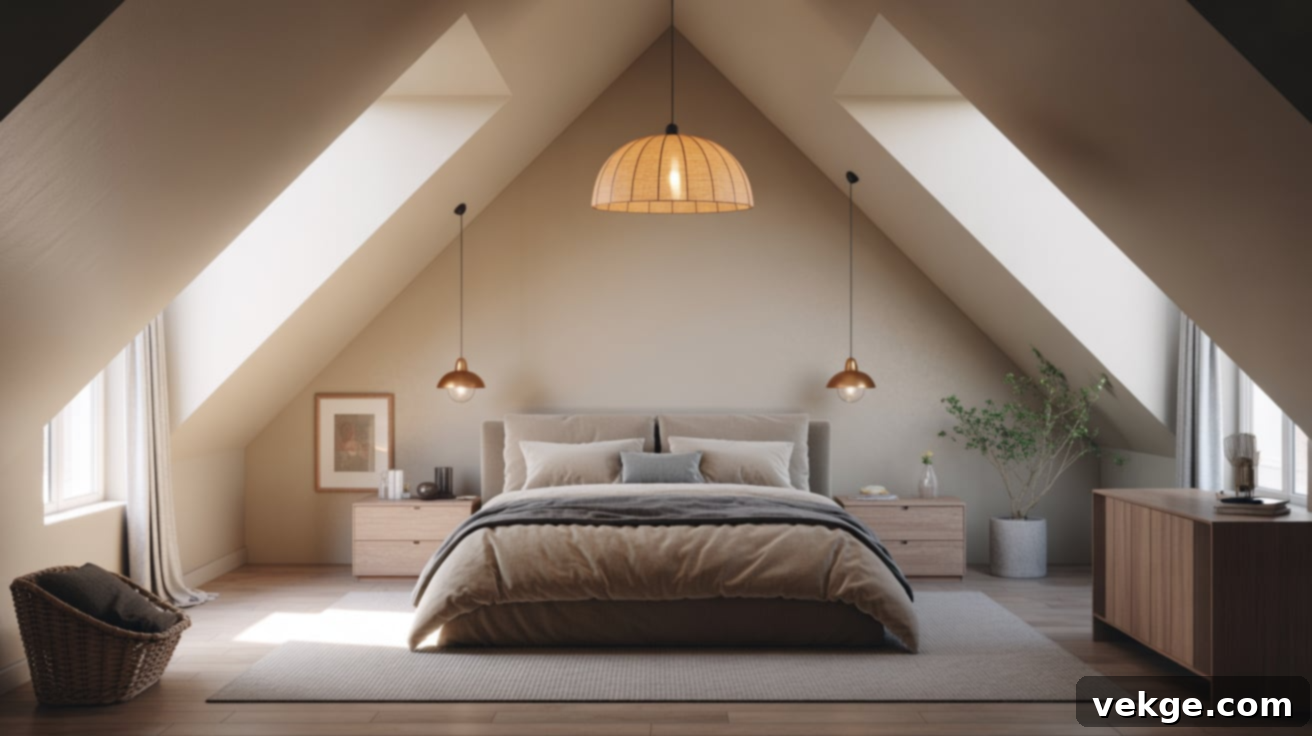
In rooms characterized by uneven ceilings, strategic placement of hanging lights is key. Position pendant lights closer to the tallest part of the room, or where the ceiling offers the most clearance. This prevents them from hanging too low in a sloped area and ensures they remain out of the way, allowing their light to disperse across a wider area of the room. This not only enhances visibility but also creates a more balanced illumination.
Opt for soft, warm-toned bulbs to cultivate a calm and inviting atmosphere, perfect for a bedroom. Beyond their functional purpose, well-chosen pendant lights can also serve as stylish decorative elements, adding a touch of sophistication while brilliantly solving a common lighting dilemma in angled spaces.
12. Use Wall Sconces
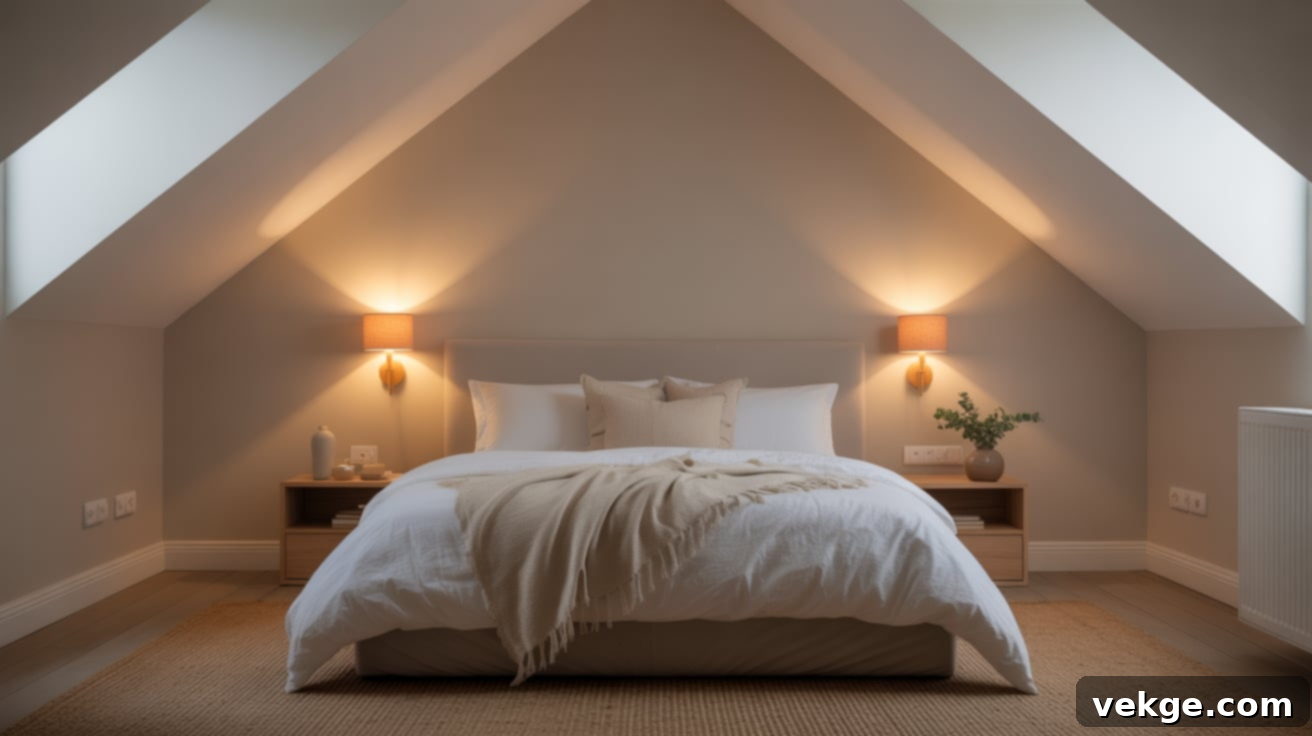
Wall-mounted lights, or sconces, are an excellent solution for spaces where traditional ceiling fixtures are impractical or simply don’t work well due to the slope. They can be strategically placed at various heights along straight walls or even on the higher sections of angled walls, providing direct or ambient light exactly where it’s needed.
Install them beside the bed for reading, in a cozy reading nook, or to highlight a specific architectural feature. For ultimate ease of installation, especially for renters or those avoiding complex wiring, choose plug-in models. Wall sconces also cleverly save surface space on nightstands or desks, keeping these areas clear and functional.
13. Add String Lights Along the Angle
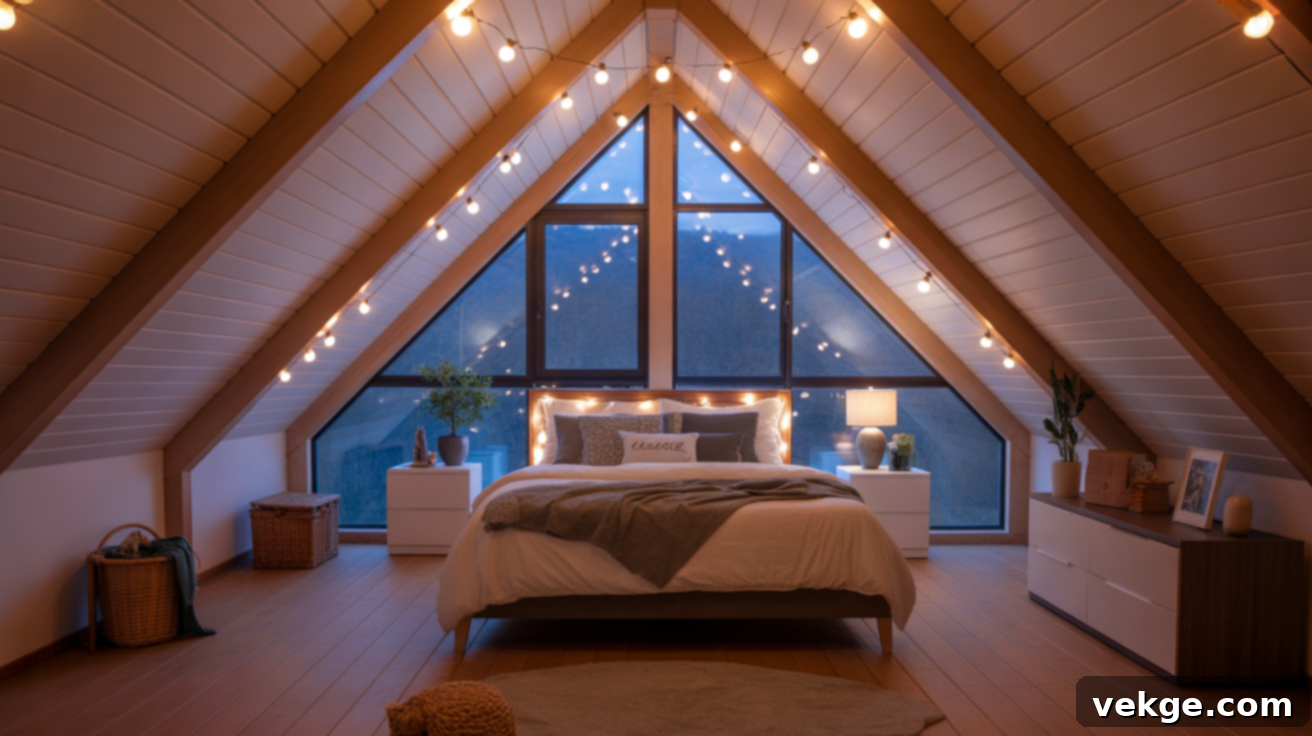
For a whimsical, warm, and utterly charming lighting effect, string lights are an inexpensive and highly adaptable option. They can effortlessly follow the unique contours and angles of your slanted ceiling, creating a soft, diffused glow that makes the entire room feel inviting and magical. They are incredibly easy to hang and are wonderfully versatile, working beautifully in adult bedrooms, children’s spaces, or even a creative home office.
Select clear or soft-colored bulbs for a gentle, ambient illumination that enhances relaxation. Beyond general lighting, string lights can also be used creatively to highlight specific parts of the ceiling, define a reading corner, or add a playful touch to a feature wall, transforming awkward angles into delightful design elements.
14. Try Clip-on or Plug-in Lamps
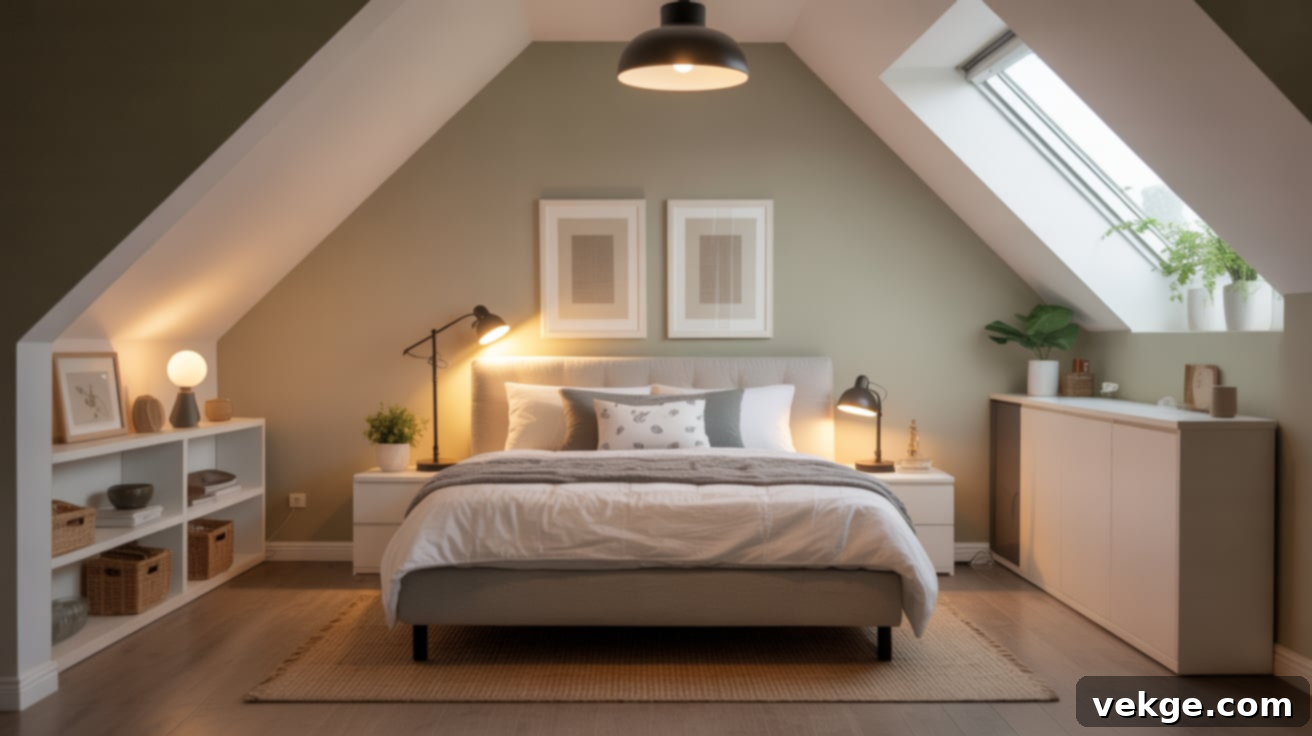
Flexibility is key in uniquely shaped rooms, and clip-on or plug-in lamps offer just that. These portable and adaptable lighting fixtures are incredibly easy to move around and reposition as needed. Clip them onto floating shelves, attach them directly to your bed frame, or place them on a small table for focused task lighting during late-night reading or creative projects.
Plug-in versions are particularly advantageous when complex ceiling wiring or electrical work is not an option, making them a smart and landlord-friendly choice. They are also ideal for shared rooms or spaces where personal lighting preferences may vary, allowing each occupant to control their light source independently.
15. Include a Floor Lamp
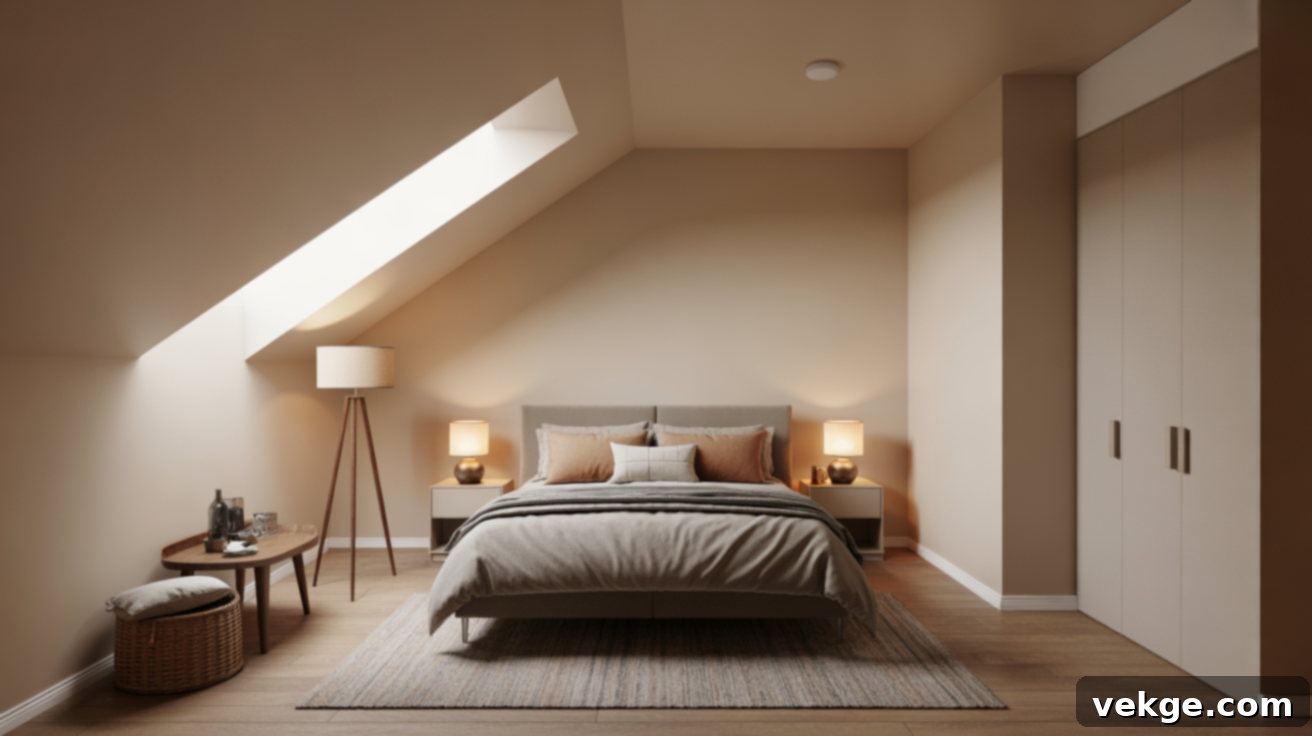
A tall floor lamp can be a powerful lighting tool in bedrooms with slanted ceilings, especially for illuminating darker corners or areas where overhead lights simply cannot reach effectively. Position a floor lamp in a corner or beside a key piece of furniture to provide both ambient and functional light.
If space is tight, opt for a model with a narrow, weighted base to minimize its footprint. Many floor lamps also offer adjustable heads, allowing them to double as task lighting near a desk or a comfortable reading chair. For a soft, indirect glow that subtly brightens the entire room, aim the light towards the ceiling, letting it reflect down and spread evenly.
Decorating Bedrooms with Slanted Ceilings
While sloped ceilings might initially feel awkward or restrictive, they actually offer a fantastic opportunity to infuse your space with unique character, making it feel more relaxed, intimate, and deeply personal. These decorating ideas are designed to help you not just live with the angles, but to highlight them, turning potential challenges into charming design assets.
16. Paint the Sloped Ceiling the Same Color as the Walls
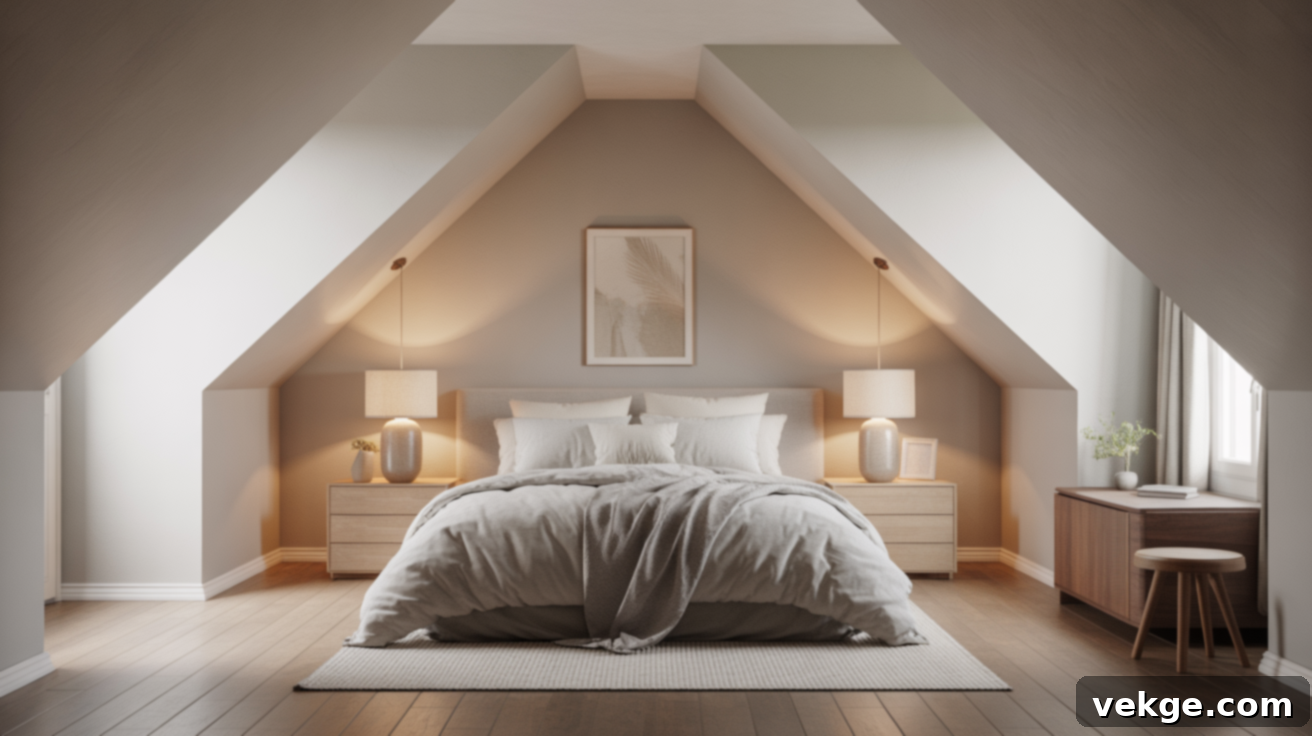
One of the most impactful and budget-friendly ways to harmonize a room with a slanted ceiling is to paint both the walls and the sloped ceiling the exact same color. This creates a visually continuous surface, effectively blending the angle into the overall architecture of the space. The result is a room that feels less busy, less choppy, and allows the eye to move smoothly around the contours of the room, creating a sense of spaciousness.
This technique brings a calm, soft, and cohesive look that works wonderfully in both small and larger bedrooms. To maximize the feeling of openness and brightness, stick with light or soft shades, such as whites, creams, light grays, or gentle pastels. You’ll likely find that the room immediately feels more expansive and serene.
17. Use Wallpaper on the Slanted Area
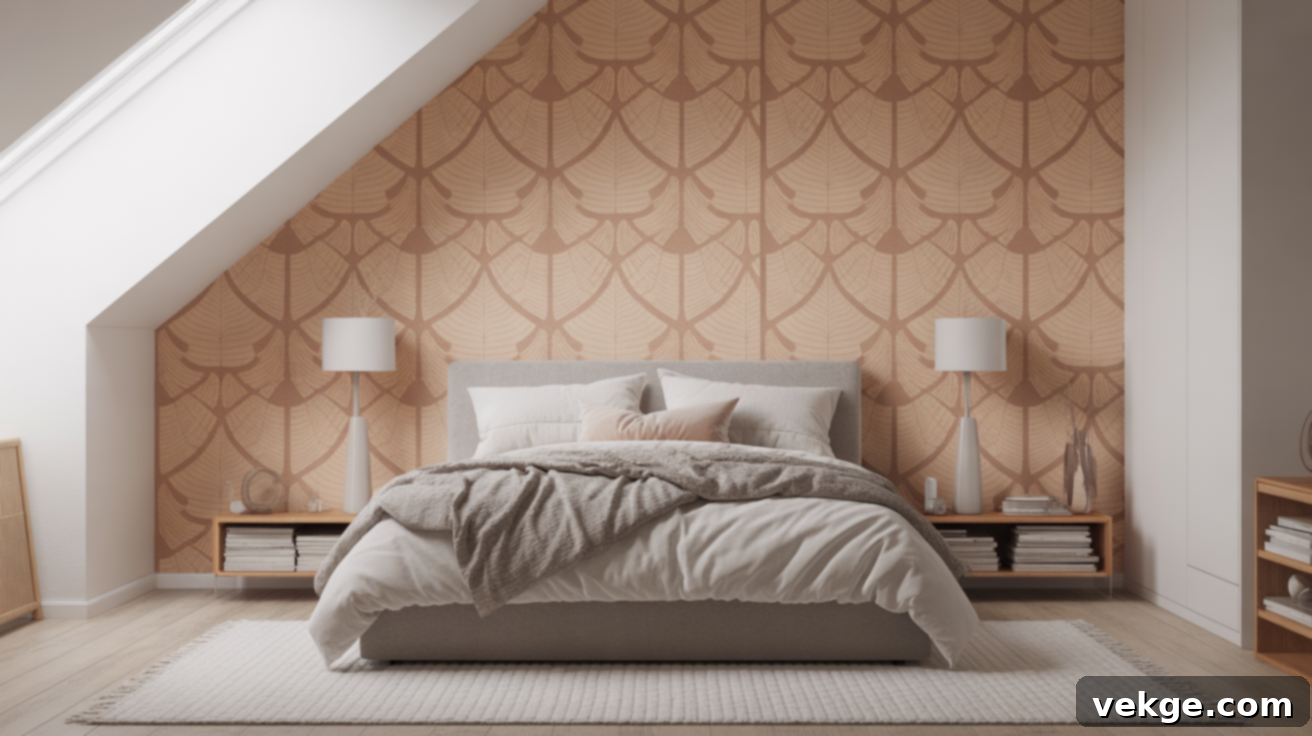
For those looking to add a touch of personality and turn the unique slope into a deliberate design feature, peel-and-stick wallpaper is an excellent and commitment-free option. This type of wallpaper is easy to apply and remove, making it perfect for renters or those who like to frequently update their decor. Choose a light pattern, a subtle geometric design, or a gentle texture that complements the existing color scheme and style of the rest of your room.
You don’t need to cover the entire sloped wall; simply adding a panel or two can introduce significant visual interest and character. This strategy works particularly well as an accent behind the bed or within a cozy reading nook, adding charm and depth without the need for additional bulky wall hangings or decorative items.
18. Add a Gallery of Small Frames
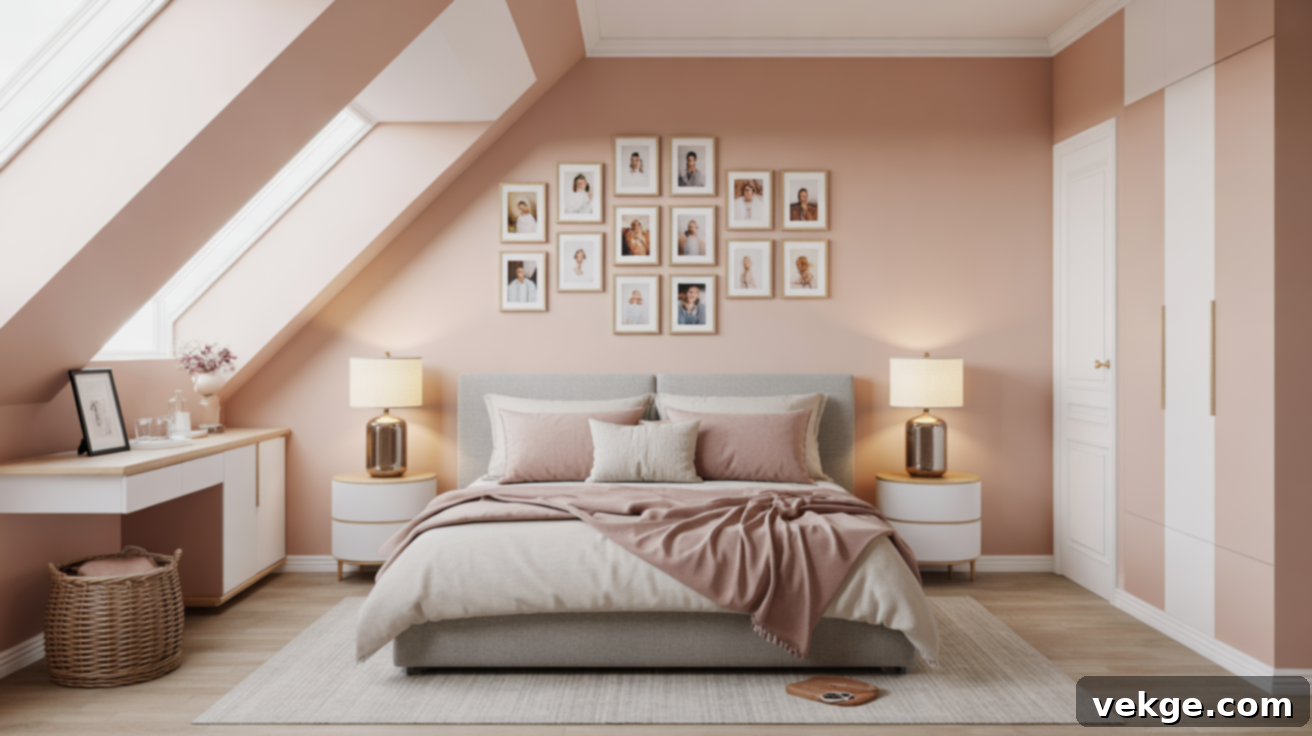
Instead of fighting the angles, use them to your advantage by creating a dynamic gallery wall that follows the slope of the ceiling. Arrange a series of small photo frames, prints, or lightweight artwork in a descending or ascending row that mirrors the angle. This design choice highlights the unique architecture while providing a compelling visual focal point.
Opt for lightweight frames and secure hanging methods to ensure safety and stability. Personalize your gallery with cherished family photos, minimalist artwork, or inspiring quotes. To maintain a sense of calm and prevent the display from feeling too overwhelming or busy, try to keep the color scheme of the frames and artwork soft and consistent, allowing the arrangement itself to be the star.
19. Put a Large Mirror in the Room
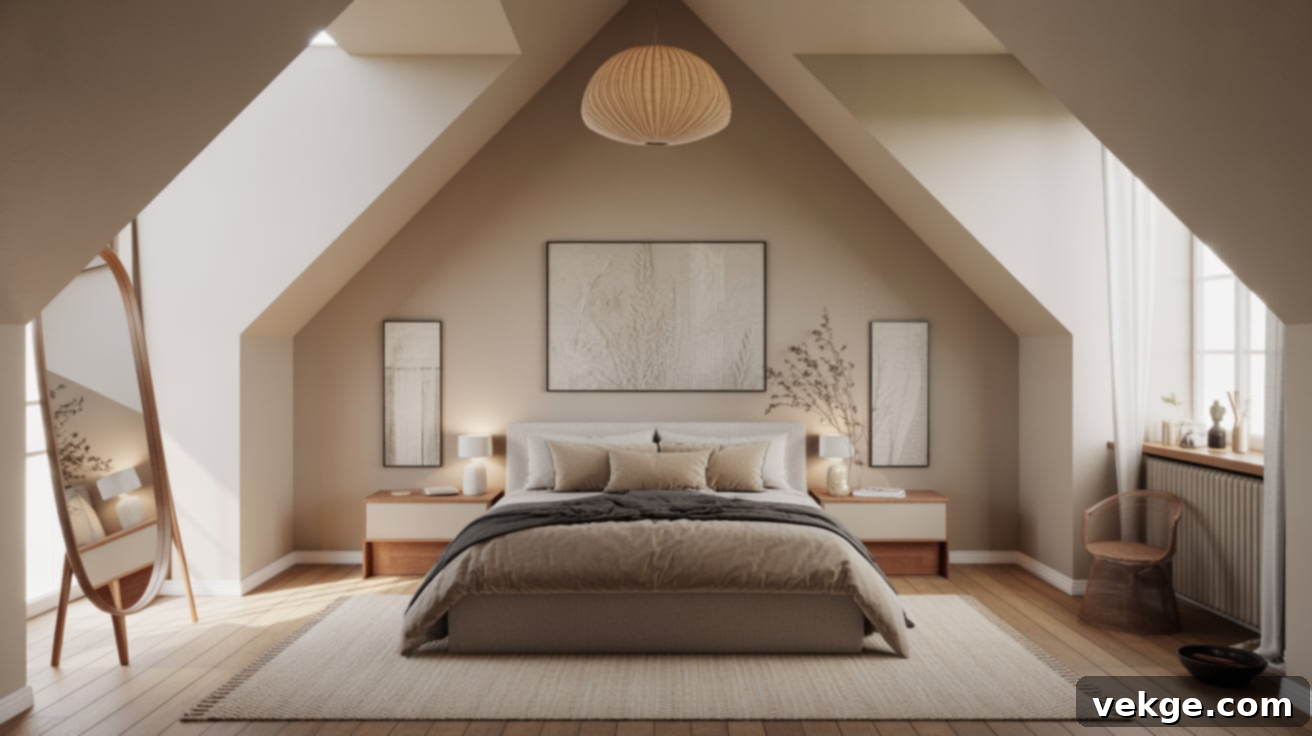
Mirrors are a designer’s secret weapon for making small or unusually shaped rooms feel larger and brighter. A strategically placed large mirror can work wonders in a bedroom with slanted ceilings by reflecting natural light and creating the illusion of greater depth and space. Identify the tallest, most open wall in your room and hang a sizable mirror at eye level, or lean a full-length mirror against it.
This not only amplifies light but also helps to visually balance the room, especially if the ceiling dips significantly on one side. A mirror with a plain, minimalist frame or no frame at all will contribute to a clean, calm, and uncluttered aesthetic, seamlessly integrating into your unique space.
20. Use Rugs to Break Up the Space
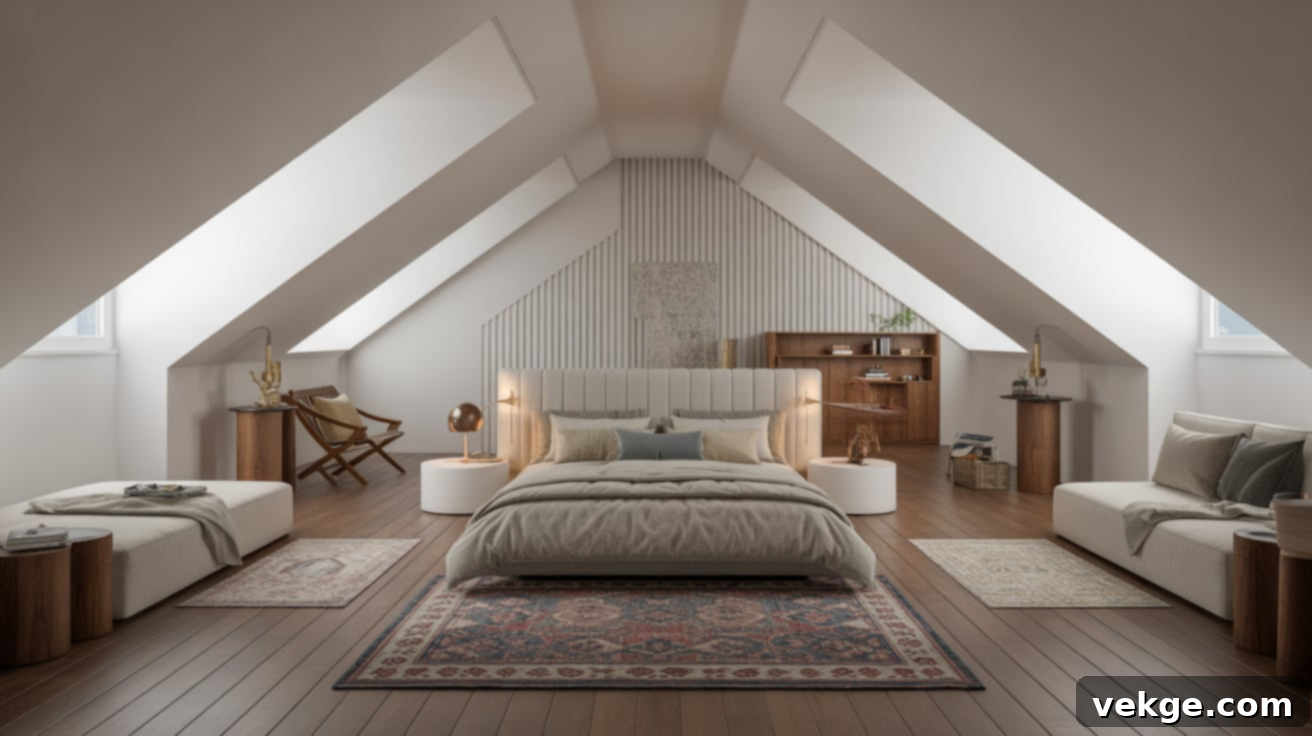
Area rugs are powerful tools for defining distinct zones within a room, which is particularly useful in open layouts or spaces with unconventional angles where traditional walls might not clearly delineate areas. You can use a large rug to anchor the sleeping area by placing it partially under the bed, a smaller one to highlight a cozy reading chair, or a runner at the foot of a storage bench.
To foster a serene and welcoming atmosphere, select rugs with soft textures and neutral tones. Beyond their visual appeal, rugs also provide an excellent way to warm up cold wood or tile floors, adding comfort and acoustic benefits. They help ground the furniture and can tie disparate elements of the room together, creating a cohesive design.
Layouts and Style Ideas
If your slanted ceiling bedroom feels a bit off-balance, or if you’re struggling to make every corner functional, a few thoughtful layout adjustments and style integrations can dramatically improve comfort and ease. These ideas focus on clever ways to utilize every part of your unique room effectively, turning awkward spaces into intentional, inviting zones.
21. Create a Reading Nook Under the Slope
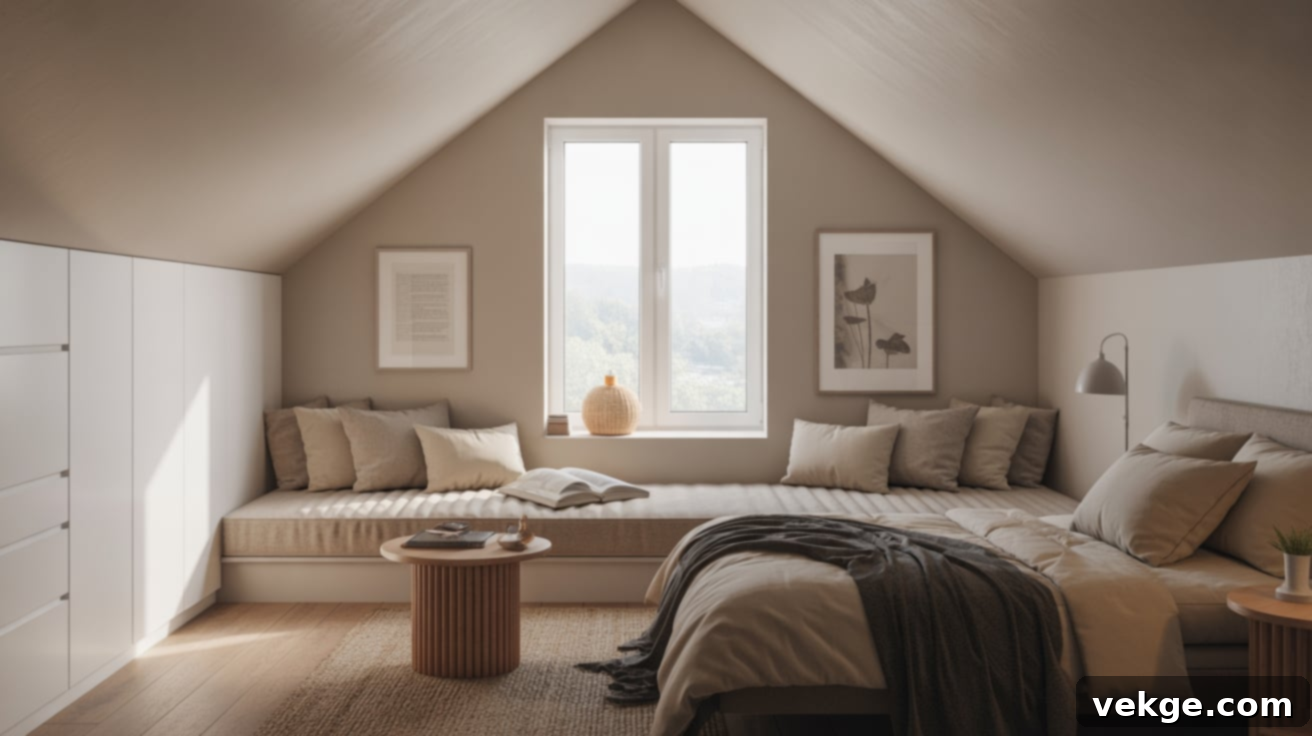
The lowest, most tucked-away part of a sloped ceiling room is often perfectly suited for creating a tranquil and intimate reading nook. This cozy corner can become your favorite spot for quiet contemplation and relaxation. Start with a plush floor pillow or a small, low-profile armchair, add a soft blanket, and a compact basket filled with your current reads.
To complete this inviting sanctuary, incorporate a wall-mounted lamp or a small, strategically placed side table with a task light. This setup works exceptionally well near a window, allowing for natural light, or tucked discreetly beside the bed, offering a private escape within your personal space. It transforms an otherwise challenging area into a highly cherished feature.
22. Make a Loft-Style Bed if the Ceiling is High Enough

For rooms with a steeply angled ceiling that still offers a significant amount of vertical clearance at its highest point, consider the transformative power of a loft-style bed. By elevating the sleeping area, you effectively free up valuable floor space underneath, which can then be repurposed for a variety of functions. This area could become a dedicated storage zone, a compact home office with a desk, or even a comfortable lounge area with a small sofa.
Crucially, ensure that the top bunk or raised platform provides ample headroom for sitting up comfortably. Always prioritize safety by installing a sturdy railing and an easy-to-use ladder or steps, creating a multi-functional and adventurous sleeping arrangement.
23. Set Up a Corner Desk
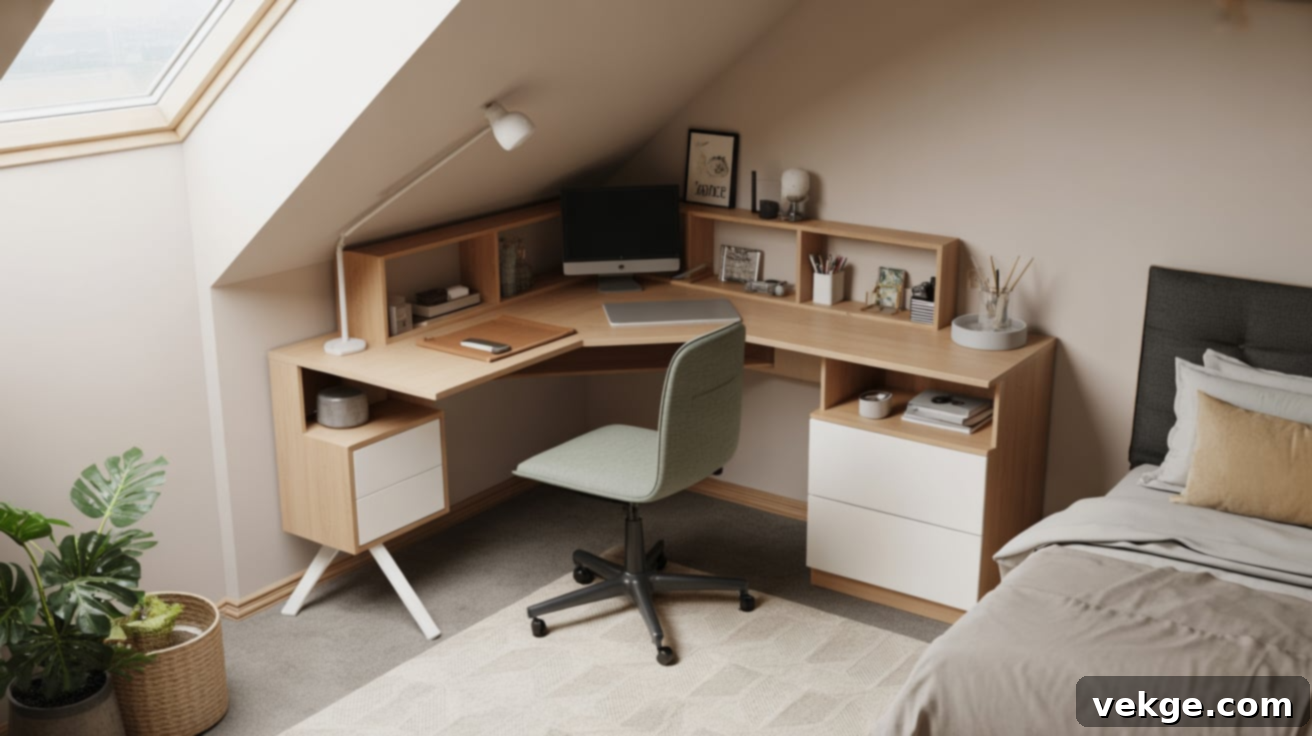
An unused corner in a room with an angled ceiling can be brilliantly transformed into a productive workspace. Opt for a compact, L-shaped, or custom-built corner desk that is specifically designed to fit snugly under the slope. This maximizes the utilization of awkward angles, turning them into practical assets.
Accessorize your corner desk with a small, focused lamp and essential office supplies to keep the area neat and functional. This type of setup is ideal for students doing homework, indulging in hobbies, or for anyone needing a dedicated spot for working from home without encroaching on the main living space. Consider hanging a corkboard or small wall organizer nearby for notes and reminders, keeping your work area clutter-free.
24. Add Plants Near Natural Light
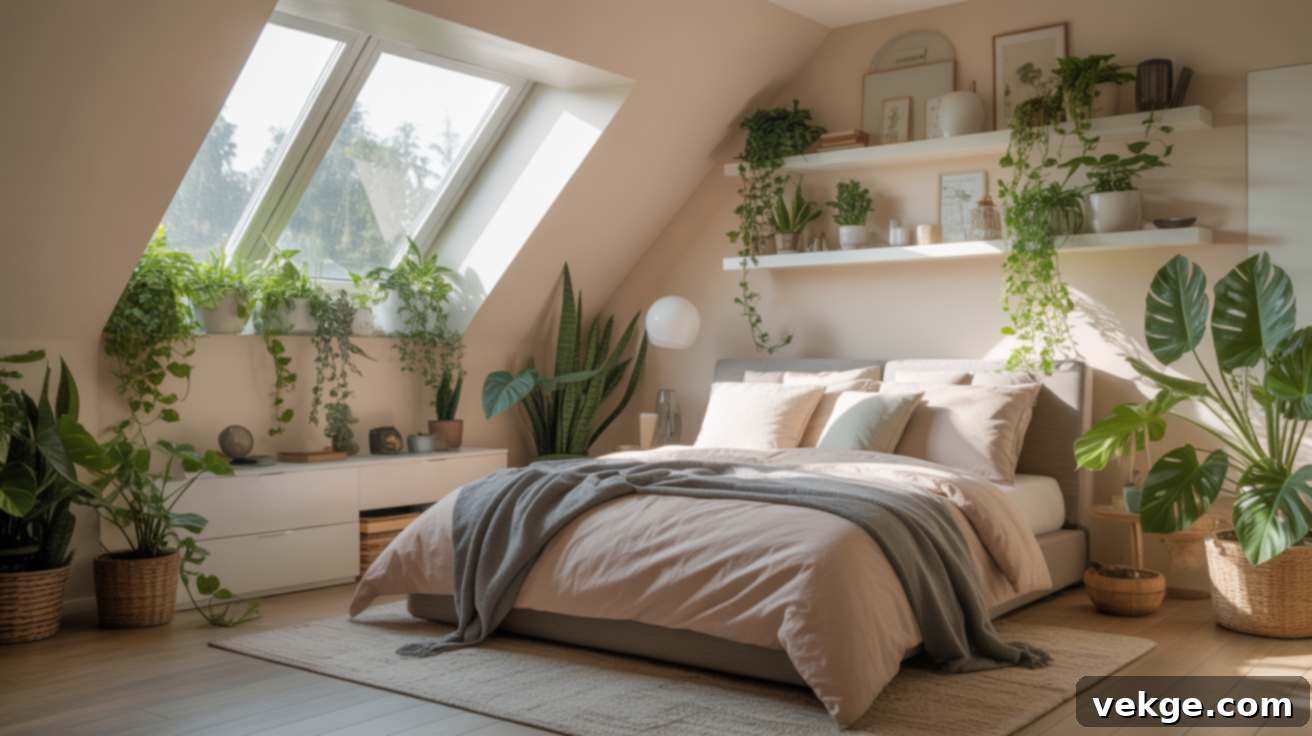
Bringing nature indoors is a simple yet incredibly effective way to infuse any room with a fresh, peaceful, and vibrant atmosphere. In bedrooms with slanted ceilings, plants can soften harsh angles and add a touch of organic beauty. If your room is blessed with a skylight, a low window, or even a small ledge, capitalize on this natural light by placing a few small, potted plants there.
Choose low-maintenance varieties that don’t require frequent watering or extensive care, making them easy to integrate into your daily routine. This adds life and color to the space and helps to break up large expanses of blank wall without the need for large, bulky furniture that might obstruct views or space.
25. Use Curtains to Define Space
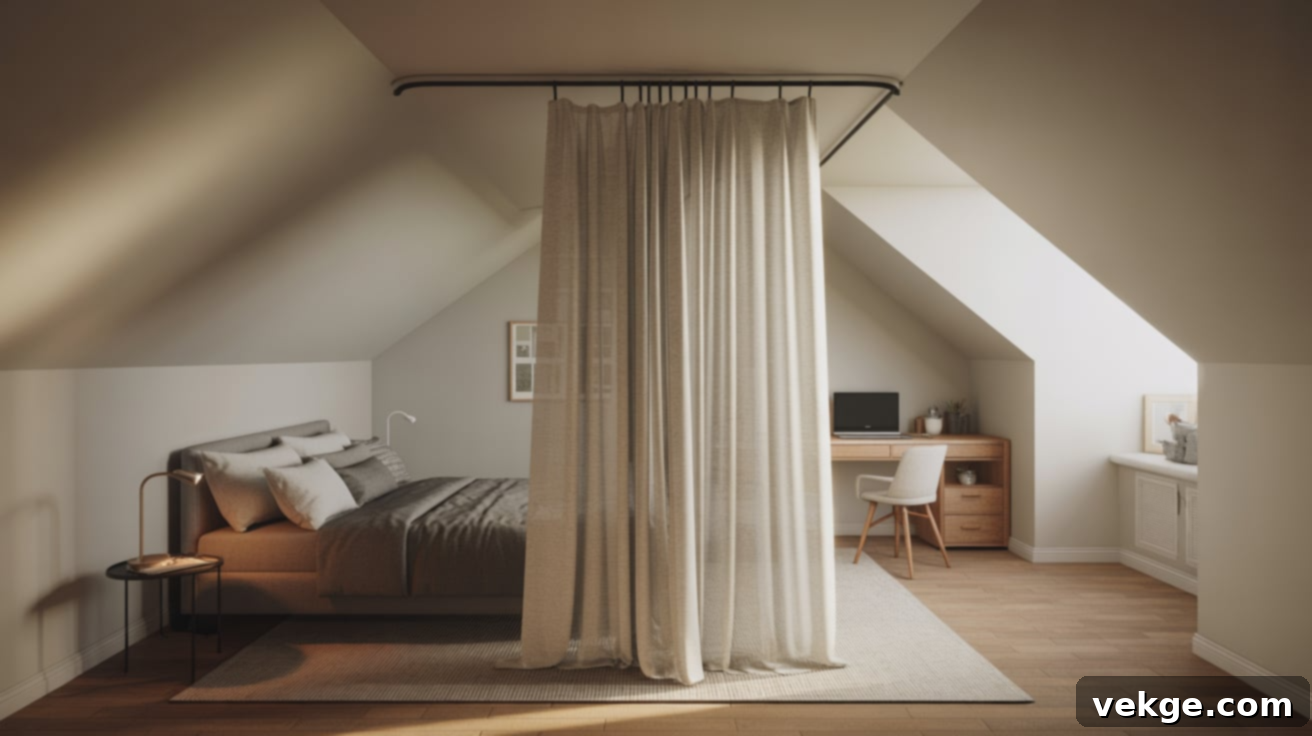
In rooms that serve multiple functions—such as a combined sleeping and working area—curtains can be an elegant and flexible solution for subtly defining different zones. Install a ceiling-mounted rod or a tension pole to hang a curtain across a portion of the space, effectively creating a gentle partition. This allows you to visually separate your bed from a desk or a reading nook, offering a sense of privacy and organization.
This clever technique keeps the room feeling calm and helps to block out visual distractions, especially useful if you need to focus on work or simply desire a more secluded sleeping environment. Opt for a light, airy fabric, such as sheer linen or cotton, to prevent the room from feeling heavy or enclosed.
Kid-Friendly and Attic Bedroom Ideas
Rooms with low or sloped ceilings often possess an inherent charm that makes them perfectly suited for children. The cozy, sometimes cave-like, feel appeals to their sense of adventure and comfort. These specialized ideas focus on maximizing space and fun in kid-friendly attic bedrooms, ensuring safety and functionality in unique layouts.
26. Add a Bunk Bed With the Lower Bed Under the Slope
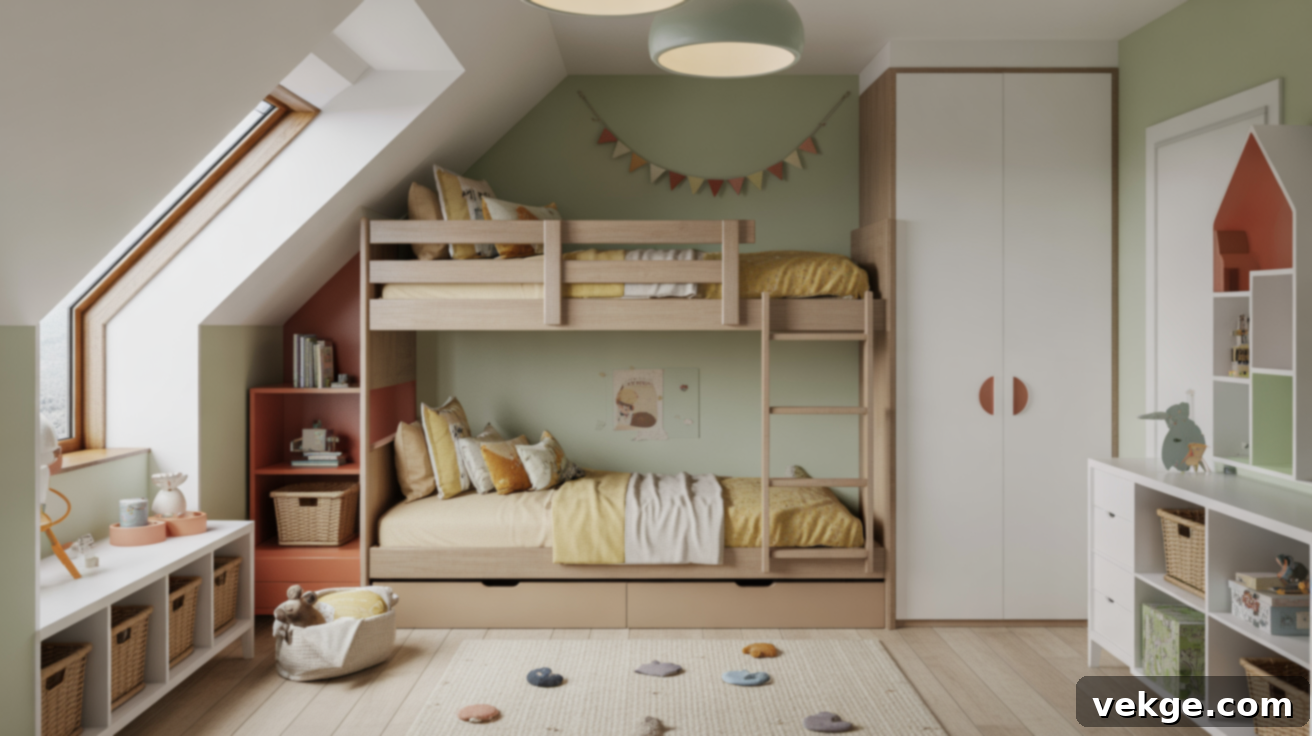
Bunk beds are an ingenious solution for shared kids’ rooms or for maximizing sleeping capacity, especially in spaces with challenging ceiling angles. Position the lower bunk directly against the lowest wall where the ceiling dips. This clever arrangement ensures that the bottom sleeper still has sufficient headroom, while the upper bunk benefits from the taller part of the ceiling.
Prioritize models that include a sturdy ladder or easy-to-climb steps for safe access to the top bunk. To further enhance functionality, choose bunk beds with integrated storage drawers or consider adding storage bins underneath the lower bed, providing extra space for toys, books, or extra bedding.
27. Try Wall Decals Instead of Frames

In a child’s bedroom with slanted ceilings, wall decals and stickers offer a fantastic, safe, and flexible alternative to traditional framed artwork. They allow for vibrant bursts of color and imaginative themes without the risk of heavy objects falling from the wall. Wall decals are incredibly easy to apply and, more importantly, can be removed without damaging the paint, allowing you to change the room’s theme as your child grows and their interests evolve.
Use them creatively on sloped walls to form captivating scenes, playful shapes, or even personalized name letters. This method is especially safe for tight spaces or areas where children might play close to the walls, ensuring a fun and worry-free environment.
28. Use Soft Bins and Low Furniture
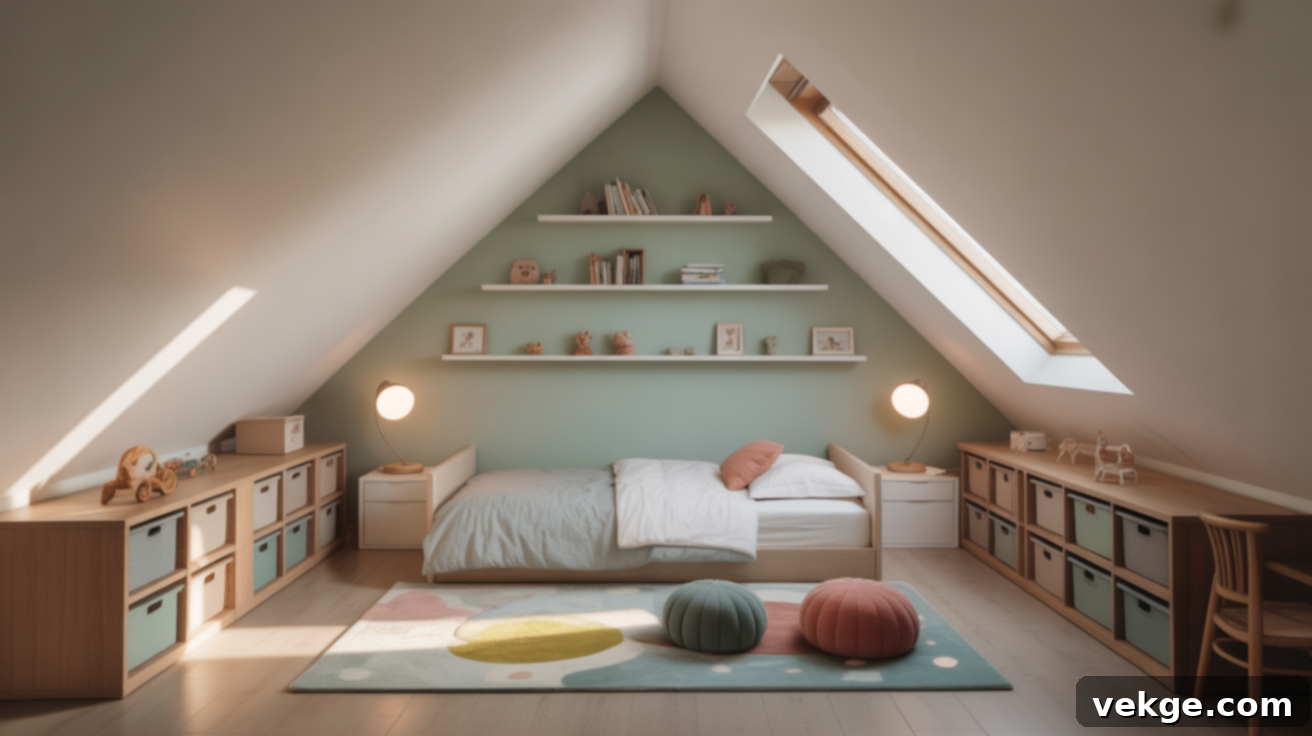
Designing a kid-friendly bedroom in an attic space means prioritizing accessibility and safety. Children’s items, especially toys and books, are much easier for little ones to reach and put away when storage furniture is low to the ground. Opt for soft fabric bins, short modular shelves, or compact toy chests that fit neatly under the angled parts of the ceiling.
This approach not only helps keep the room tidy and organized but also fosters a sense of independence in children as they can manage their belongings themselves. Avoid tall, unstable bookcases or bulky furniture items that might block natural light or pose a safety hazard in a room with limited vertical space.
29. Paint With Light or Bright Colors

The right paint colors can dramatically transform the feel of an attic bedroom, especially for children. Using light, bright, or cheerful pastel shades can make the space feel more expansive, airy, and inviting. Soft blues, sunny yellows, gentle greens, or classic pastels are excellent choices as they naturally reflect light, creating an illusion of higher ceilings and a more open environment.
It’s generally best to avoid dark shades on the sloped ceiling itself, as these can make the ceiling feel lower and more oppressive. However, a single, brightly painted accent wall can add a playful burst of color and personality without cluttering the space or making it feel smaller.
How to Choose the Right Ideas for Your Room
Before you dive headfirst into making changes, taking a moment to thoroughly assess your space and define your needs will guide you toward the most effective design solutions. A few simple, yet crucial, checks can help you select the ideas that perfectly fit your unique room and align with your lifestyle, ensuring your efforts lead to a truly functional and beautiful outcome.
- Measure Thoroughly: Begin by precisely measuring the ceiling height at both its lowest and highest points. Note any significant architectural features like beams or windows. This critical information will dictate what kind of furniture will realistically fit and where it can be optimally placed, preventing frustrating mistakes.
- Define Room Purpose: Clearly determine how you intend to use the room. Will it be a tranquil haven for restful sleep, a vibrant and fun space for children, a multi-functional guest room, or perhaps a creative studio? Your primary use case will heavily influence decisions regarding layout, storage, and ambiance.
- Prioritize Practicality: From the multitude of suggestions, select those that make the most logical sense for your specific space and needs. You don’t need to implement every single idea; instead, focus on a few key changes that promise the greatest impact and solve your most pressing design challenges.
- Focus on Flow and Usability: Above all, ensure the redesigned space is easy to navigate and highly functional. Confirm that you can comfortably walk around furniture, sit up in bed without hitting your head, and access storage without feeling cramped or hindered. An ergonomic and intuitive layout is paramount.
- Layer Decor Last: Once the foundational elements of layout, essential furniture, and lighting are in place and working well, then introduce color, textures, and small decorative touches. This allows you to personalize the room and reflect your unique taste, adding comfort and aesthetic appeal to an already functional space.
Conclusion
You now possess a comprehensive toolkit of ideas to help you not just live with, but truly celebrate, the unique angles of your bedroom. From innovative bed placements that maximize comfort to ingenious storage solutions, creative lighting tricks, and cozy decorating strategies, each tip has been thoughtfully designed to help you make the absolute best use of your sloped ceiling space. The goal is to transform what might initially seem like a design challenge into a distinctive and cherished feature of your home.
Remember, the ultimate success of any design lies in how the room feels and functions for you. Your bedroom should be a sanctuary that’s easy to move through, wonderfully comfortable for resting, and thoughtfully shaped in a way that perfectly fits your individual needs and preferences. Don’t be afraid to experiment; try a few different changes, take your time to live with them, and adjust things until every corner of your room feels absolutely right.
Should you find yourself still seeking further inspiration or specific guidance for other areas of your home, we encourage you to explore our extensive collection of blogs. You’ll find a wealth of information on small room design, shared living spaces, and practical decor tips crafted to fit real-life scenarios and help you create beautiful, functional environments.
